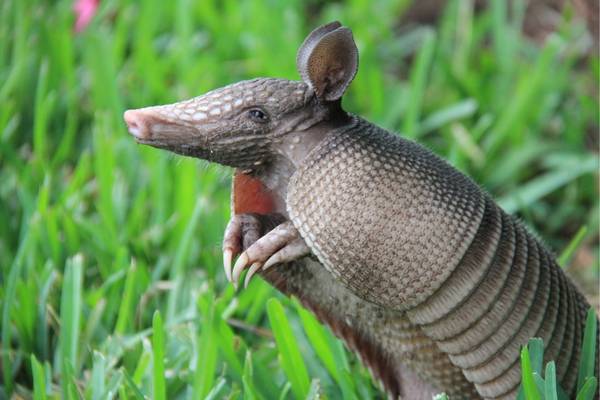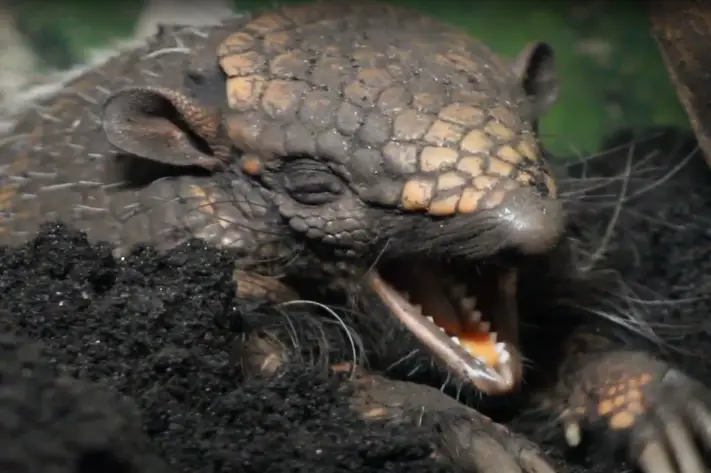There’s been a lot of talk about armadillos attacking dogs lately. While it’s true that armadillos can carry a number of diseases that can be harmful to dogs, they’re not typically aggressive animals and are more likely to run away from a dog than attack it.
So the short answer is that armadillos will not normally attack dogs unless the dog is very incitingly provoking it! Armadillos are generally shy and timid animals that prefer to avoid confrontation. However, if an armadillo feels threatened, it may attack mainly using its claws. Read on to learn how to prevent it!
An armadillo is a small to medium-sized mammal found in the Americas. The nine-banded armadillo is the most common species and can be found as far north as the United States and as far south as Uruguay.
They are known for their hard, shell-like armor which protects them from predators and prey alike.
When they get scared they roll up into a ball, which makes them interesting for dogs to play with. The dog’s enthusiasm to play will sometimes be misunderstood as a threat by the armadillo and can lead to nasty encounters between the two.
While an armadillo attack is unlikely to seriously injure a healthy dog, it could cause puncture wounds or scratches. If your dog does get into a scuffle with an armadillo, be sure to check for injuries and consult your veterinarian if necessary.
Are armadillos dangerous to dogs?
The short answer is yes. Armadillos can transmit leprosy to dogs (and humans), so it’s important to take steps to avoid contact between your dog and these critters.
But why is armadillo leprosy such a big deal? This disease can cause nerve and tissue damage, leading to skin lesions and lameness.

You may be surprised to learn that armadillos carry this infection – armadillo leprosy is extremely rare in the U.S., but it’s still good to know about it.
Armadillos are the only animals that can carry leprosy in the U.S, so it’s important to know how to tell if you spotted one of these creatures.
Their carapace (armored shell) can get fairly thick, so they may not be visible from a distance. Look for a long tail and scaly feet, and look for a snout that looks like a little pig.
Of course, armadillos are only one critter that could be carrying leprosy. Remember, your dog could come into contact with an infected animal anywhere: at the park, at the groomer, at a friend’s yard…anywhere!
Are armadillos bad for dogs?
If you’re a dog owner in the southern United States, you’ve probably heard warnings about armadillos. These strange, armored creatures can carry a nasty disease called leprosy, which can be passed on to dogs (and humans) if they come into contact with an infected animal.
However, if an armadillo feels threatened, it may lash out with its powerful claws, which could cause serious injury to a dog. If you have an armadillo on your property, the best thing to do is to follow some of the steps below to make sure your dog is kept safe.

So, are armadillos really dangerous? They’re not life-threatening, but they can pass on a nasty infection called leprosy.
Since they’re so uncommon in the United States, armadillos may not be on your radar, but if you keep the below tips in mind, you’ll be well on your way to keeping your dogs or other pets healthy and safe.
Leprosy is a serious bacterial infection that causes disfiguring skin lesions and nerve damage. It’s relatively rare in the U.S., but armadillos are the only animals that can carry the disease and pass it on to other animals (including humans). If your dog comes into contact with an infected armadillo, he or she could develop leprosy as well.
There’s no need to panic if you live in an area where armadillos are common – just take some basic precautions to keep your dog safe. Keep him or her away from areas where armadillos have been seen and don’t let your pup roam off-leash in areas where these animals might be present.
If you suspect that your dog has come into contact with an armadillo, watch for signs of leprosy (skin lesions, nerve damage) and seek veterinary care immediately as it can be treated with antibiotics.
Do Armadillos Bite?
Armadillos are not typically aggressive animals, but they will bite if they feel very threatened, although they most often try to scratch the attacker first!
Armadillos snap more than they bite really hard and they have fairly small teeth, so their bites are not too bad.

However, their bites can be painful to a dog, but they are not poisonous or venomous and most often will not be dangerous. If your dog is bitten by an armadillo, wash the wound with soap and water and seek veterinary attention if necessary.
As mentioned above, there is also a small chance of your dog contracting leprosy, but this is considered rare.
However, armadillos do not usually bite dogs but they can scratch them with their claws if surprised or attacked by the dog.
Will armadillos eat my pets?
Armadillos normally eat a variety of things, including insects, grubs, frogs, and snails. They’ll even eat your trash.
Armadillos are carnivores and mostly eat insects, spiders, and other small invertebrates. They may therefore eat small pets such as lizards, snakes, and rodents if these come in contact with an armadillo!
However, they are not likely to attack and eat larger animals such as cats or dogs.
Armadillos generally do not eat domestic pets, though they may have to defend themselves against rodents, rabbits, dogs and cats upon encounter in your yard.
Armadillos have been known to attack and eat small or weakened cats and dogs, but this is very rare!
What can I do to keep armadillos away from my pets?
There are a few things you can do to keep armadillos away from your pets. The first is to keep your pet’s food and water inside.
This will make it less likely for armadillos to come around looking for a meal. You should also keep your pet’s area clean and free of any potential food sources, such as garbage or fallen fruit.
If you have a fence, make sure it is in good repair and does not have any gaps that an armadillo could squeeze through.
Finally, you can try using ultrasonic repellent machines around your property to help discourage armadillos from coming close.
Ultrasonic Emitters to Scare Armadillos Away
My absolute favorite invention to keep pests away from my backyard are these cool solar-powered ultrasonic sound emitters that you can buy right off Amazon!
They send out loud or consistent noises (that only they can hear) that will scare them away or at least shorten their visits significantly!
In my experience, they really work, and the solar panels on top save you the time and money of changing batteries all the time.
Other tricks you can try are:
1. Remove all potential food armadillo sources, such as garbage, pet food, and fallen fruit.
2. Keep the area around your home free of dense vegetation that armadillos can use for cover.
3. Install barriers, such as fencing, underground to prevent armadillos from digging under foundations or into yards.
Conclusion
Dogs do not normally pose a threat to armadillos, but an armadillo may bite or scratch a dog if it feels threatened. A bit like groundhogs would also bite when threatened, but hey are not normally aggressive towards humans and pets.
They can transmit leprosy to dogs, which can cause nerve and tissue damage, but this is very rare.
If your dog comes into contact with an armadillo, watch for signs of leprosy and seek veterinary care immediately.
You can also take some basic precautions to keep your dog safe, such as keeping him or her away from areas where armadillos have been seen and not letting your pup roam off leash in areas where these animals might be present.
The best way to prevent your dog from coming into contact with an armadillo is to keep an eye on him or her and avoid areas that may be frequented by armadillos.







